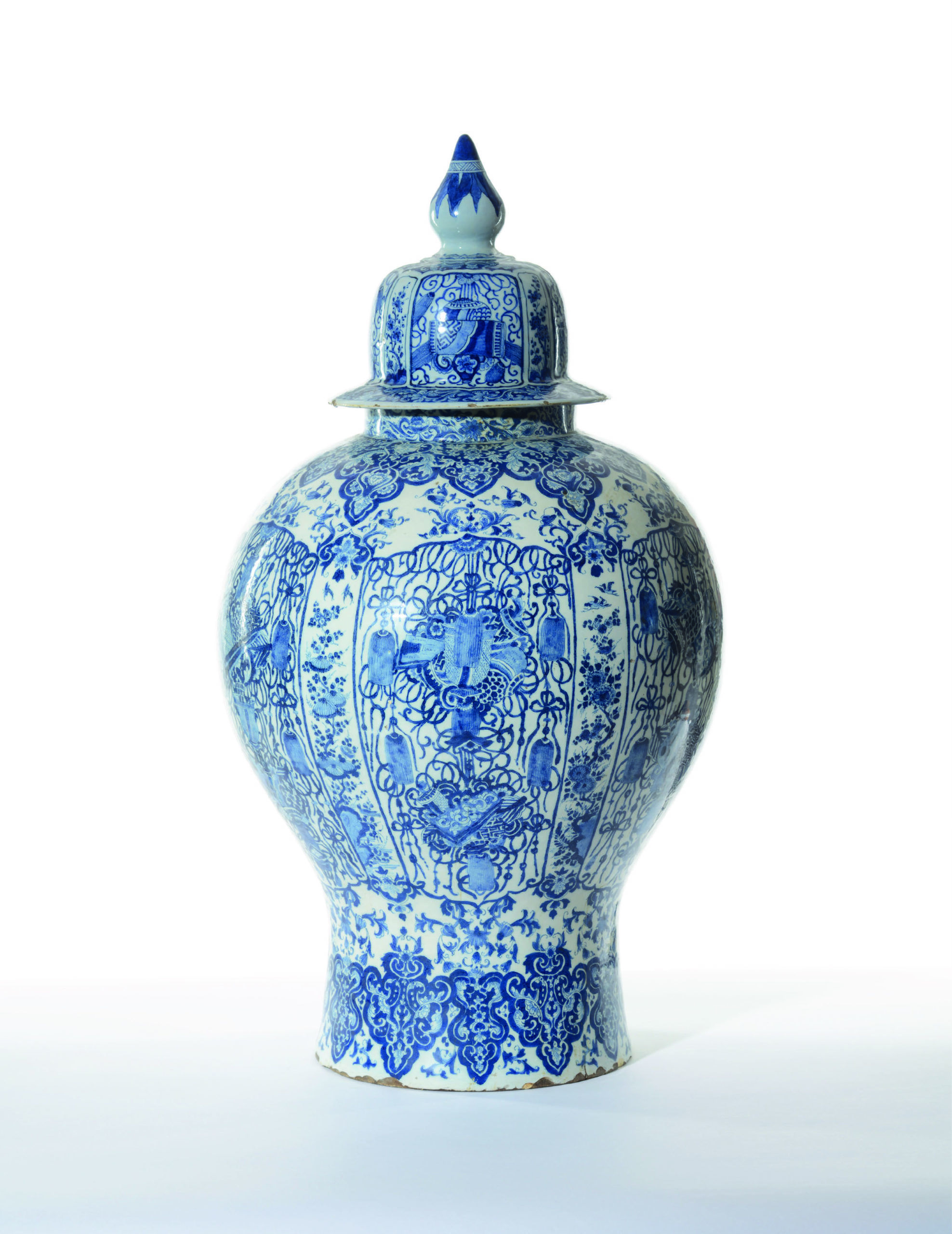
[popup_trigger id=”13756″ tag=”span”]![]() [/popup_trigger]
[/popup_trigger]
Images on this website are licensed under a
Creative Commons Attribution-NoDerivs 3.0 Unported License.
OBJECT
D2134. Blue and White Large Vase and Cover
Delft, circa 1700
Painted on the baluster-shaped body with six large panels with auspicious symbols such as scrolls, tassels, lanterns and ribbons, separated by tall bands of flowering plants growing behind stylized rock work and with birds in flight between ruyi-heads reserved with a leaf motif, all in between stylized floral scrollwork, the lower rim with a wide lappet border reserved with floral scrollwork and repeated on the shoulders of the vase reserved with floral scrollwork and centered with masks of lions and cherubs, the neck with a floral scroll border, the cover painted with four panels with auspicious symbols separated by bands of flowering plants, its wide rim with a flowering scroll border which is repeated on the top, and surmounted by a teardrop-shaped finial painted with stiff leaves.
DIMENSIONS
Overall height: 72 cm. (28.3 in.)
PROVENANCE
Belgian Private Collection
NOTE
Auspicious symbols as painted in the large panels on the present jar can often be found on the paneled rim of Kraak-porcelain. Although on Chinese porcelain, the scenes were symbolic for Daoist immortals, the eight precious things or Buddhist symbols, which all had their own meaning. These particular meanings were lost in Delftware. The Delftware painters chose the decoration for their exotic and luxurious character that was so desired by their clientele. The symbols are therefore not direct copies of their counterparts on Chinese porcelain. However, someobjects can be identified, such as the scroll. The scroll is the sacred text of the scriptures and the story of truth, and is believed to provide happiness. The lantern is the symbol of joy and festivities; it is often given as an auspicious gift at weddings, and plays an important role in social and religious life. As on Chinese porcelain, all these emblems are set on a background of tassels and ribbons.
These Chinese motifs are combined with the exuberant baroque style that was en vogue at the moment in Europe, such as the lambrequins and perhaps most notable as European: the masks of lions and cherubs. In France, the motif was used by Jean Berain (1640-1711), designer for the court of King Louis XIV. Berain’s style was characterized by delicate arabesques and whimsical grotesques that originally derived from the Renaissance. Using light floral patterns, Berain famously combined foliage with human and animal forms that prefigured the Rococo movement. His style was first adopted by the maiolica potteries from Rouen, where the use of lambrequins evolved toward an extreme refinement. The French designer Daniel Marot later exported Berain’s style to the Netherlands, when he was employed by William III and Mary II to redesign the Palace Het Loo after the revocation of the Edict of Nantes by Louis XIV.
Around 1700 there were only a few factories that had the skill and expertise to produce such a large, high quality object as the present vase: De Grieksche A (The Greek A),De Metaale Pot (The Metal pot) and De Witte Starre (The White Star) factory.
The masks in the large lappets of the shoulder are a defining feature of the vase. Masks were a decorative device influenced by the French court and its designers, and they are often seen on Delftware at this time. The masks in this vase are markedly unique because of their placement in blue-ground lappet borders, and decorated with floral scrollwork. This motif is not uncommon on objects created by De Witte Starre factory. A large vase with the coat of arms of the Creagh family of Ireland, marked WB and an asterisk for Dirck Witsenburgh, is also decorated with a similar border of blue-ground lappets with blossoms, scrollwork and masks. Although smaller, the blue lappet border on a pair of octagonal bottle vases in a private collection, marked with an asterisk-type star, WB and the dashed numeral 7, is reserved with floral scroll devices and masks. Faces of cherubs with wings in or flanking blue-ground lappets are also common on De Witte Starre objects, for example on a serving jug from circa 1700 produced at De Witte Starre factory in the collection of the Boijmans van Beuningen Museum in Rotterdam (inv. no. A 4043 a-b [KN&V]), on the neck of a wine pitcher from circa 1675-1725 by De Witte Starre factory in the same museum (inv. no. A 5166 [KN&V]) and on an octagonal bottle shaped vase, from circa 1700-1710 marked for De Witte Starre factory in the Rijksmuseum, Amsterdam (inv. no. BK-1962-60).
Further, the floral scroll motifs also fit within the repertoire of De Witte Starre factory, just like the birds in flight. For example, the motif is seen on the large vase bearing the coat of arms of the Creagh family, a pedestal base of a pyramidal flower vase, marked for Dirck Witsenburgh, sold at Christie’s Amsterdam May 15, 2002, sale 2547, Lot 399, a single pyramidal flower vase in the Musée du Louvre marked for Dirck Witsenburgh (inv. no. OA 4040), and a pair of pyramidal flower vases attributed to Dirck Witsenburgh, illustrated in Aronson 2016. The Kraak-style decoration of auspicious motifs however is not typical for objects produced at De Witte Starre factory.
Based on the decoration, it is plausible that the vase was produced at De Witte Starre (The White Star) factory during the partial ownership of Dirck Witsenburgh from 1690 to 1704.
SIMILAR EXAMPLES
Objects with this Kraak-style pattern are mostly found on chargers and jugs, but are uncommon on jars.








